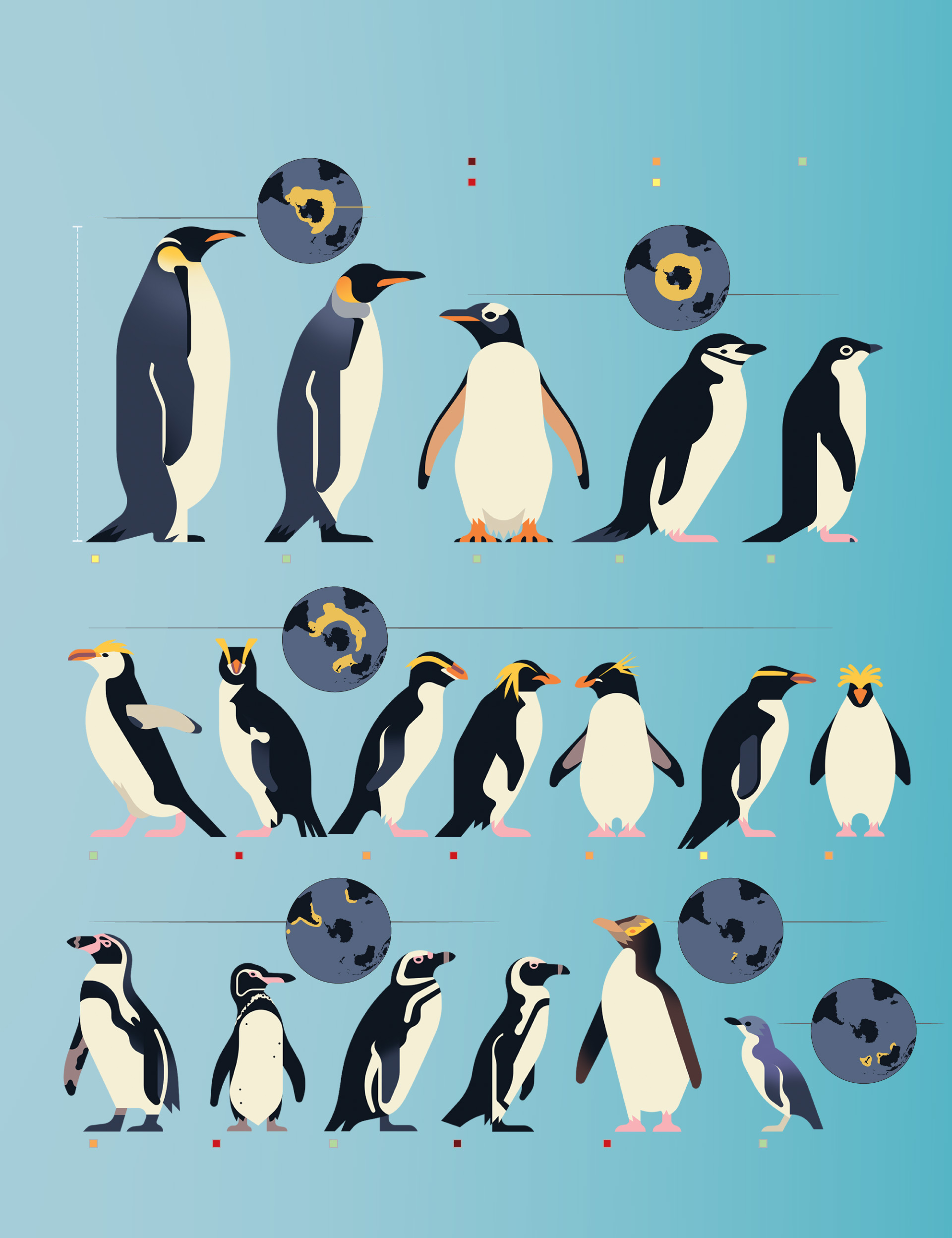
How penguins conquered the Southern Hemisphere
From the icy shores of Antarctica to the warm coasts of the Galápagos Islands, penguins have shown an exceptional ability
to breed in surprising places. Their secret? They are superbly acclimated to the marine cold—living, feeding, and breeding
near branching currents that flow out of the Southern Ocean. The 18 species are uniquely adapted to their particular habitat.
Diversity of Penguins
by genus
Conservation status
Range of
genus
Vulnerable
Least
concern
Critically endangered
Near threatened
Endangered
Great penguins
Aptenodytes
Range of
genus
Brush-tailed penguins
Pygoscelis
48
inches
tall
48
inches
tall
Emperor
King
Gentoo
Chinstrap
Adélie
Crested penguins
Eudyptes
Royal
Erect-crested
Snares
Northern
rockhopper
Southern
rockhopper
Fiordland
Macaroni
Banded penguins
Spheniscus
Megadyptes
Eudyptula
Little
Humboldt
Galápagos
Magellanic
African
Yellow-eyed
Maps: Matthew W. Chwastyk and Brad Scriber, NGM Staff. Art: Owen Davey.
Sources: Pablo Borboroglu, Global Penguin Society; Birdlife International; IUCN Red List

How penguins conquered the Southern Hemisphere
From the icy shores of Antarctica to the warm coasts of the Galápagos Islands,
penguins have shown an exceptional ability to breed in surprising places.
Their secret? They are superbly acclimated to the marine cold—living, feeding,
and breeding near branching currents that flow out of the Southern Ocean.
The 18 species are uniquely adapted to their particular habitat.
Diversity of Penguins
by genus
Conservation status
Range of
genus
Critically endangered
Endangered
Great penguins
Aptenodytes
Range of
genus
Vulnerable
Near threatened
Least concern
48
inches
tall
48
inches
tall
Emperor
King
Brush-tailed penguins
Pygoscelis
Gentoo
Chinstrap
Adélie
Crested penguins
Eudyptes
Royal
Erect-crested
Snares
Northern
rockhopper
Southern
rockhopper
Fiordland
Macaroni
Banded penguins
Spheniscus
Humboldt
Galápagos
Magellanic
African
Megadyptes
Eudyptula
Little
Yellow-eyed
Maps: Matthew W. Chwastyk and Brad Scriber, NGM Staff. Art: Owen Davey.
Sources: Pablo Borboroglu, Global Penguin Society; Birdlife International; IUCN Red List

How penguins conquered
the Southern Hemisphere
From the icy shores of Antarctica to the
warm coasts of the Galápagos Islands,
penguins have shown an exceptional
ability to breed in surprising places.
Their secret? They are superbly
acclimated to the marine cold—living,
feeding, and breeding near branching
currents that flow out of the Southern
Ocean. The 18 species are uniquely
adapted to their particular habitat.
Diversity of Penguins
by genus
Conservation status
Critically endangered
Endangered
Vulnerable
Near threatened
Range of
genus
Least concern
Great penguins
Aptenodytes
Range of
genus
48
inches
tall
Emperor
King
Brush-tailed penguins
Pygoscelis
Gentoo
Chinstrap
Adélie
Crested penguins
Eudyptes
Royal
Erect-crested
Snares
Northern
rockhopper
Southern
rockhopper
Fiordland
Macaroni
Banded penguins
Spheniscus
Humboldt
Galápagos
Magellanic
African
Megadyptes
Eudyptula
Little
Yellow-eyed
Maps: Matthew W. Chwastyk and
Brad Scriber, NGM Staff. Art: Owen Davey.
Sources: Pablo Borboroglu, Global
Penguin Society; Birdlife International;
IUCN Red List